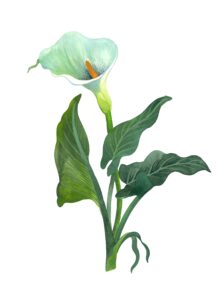 Plath, Paintings, and Plants
Plath, Paintings, and Plants
By Gabi Dondes (’26)
Sylvia Plath’s poem “Yadwigha, On a Red Couch, Among Lilies” responds to Henri Rousseau’s famous painting “The Dream.” Plath sometimes visited museums when lacking inspiration, and may have been attracted to this painting because of its botanical content. During her time at Smith College, Plath took a year-long General Botany course with Kenneth Wright that fascinated her and inspired her to use botanical imagery throughout her work. Similarly, Henri Rousseau himself visited the popular botanical gardens in Paris frequently and used them as a reference to create his post-impressionist paintings, including “The Dream.” Artists and writers such as Plath and Rousseau gravitate towards botany in order to utilize it not only for mere inspiration but also, more importantly, to communicate a sense of empathy and other humanistic ideals.
Sylvia Plath’s poem on Rousseau’s painting reveals more about the painting itself and the underlying motivations behind her writing about this specific work. Furthermore, Plath was drawn to the botanical imagery in Rousseau’s painting and related to the lore behind it. She writes in the last stanzas (Plath 2018: 86):
And that, Rousseau told the critics, was why the couch
Accompanied you. So they nodded at the couch with the moon
And the snakecharmer’s song and the gigantic lilies,
Marvelingly numbered the many shades of green.
But to a friend, in private, Rousseau confessed his eye
So possessed by the glowing red of the couch which you,
Yadwigha, pose on, that he put you on the couch
To feed his eye with red: such red! under the moon,
In the midst of all that green and those great lilies!
Rousseau’s painting was initially confusing to viewers as it featured a woman on a lush, velvet couch in a wild jungle with “monstrous” lilies (Line 7). In order to appeal to this larger audience’s understanding of his painting, Rousseau labelled this juxtaposition a dream, as Plath suggests; Yadwigha, on the couch, was dreaming of a jungle with a snakecharmer’s music. He even went so far as to write this into an accompanying comment to his painting: “The woman asleep on the couch is dreaming she has been transported into the forest, listening to the sounds from the instrument of the enchanter” (Rousseau n.d.). However, Plath highlights the true motivation behind his painting in her poem: that Rousseau, to a friend “confessed his eye [s]o possessed by the flowing red of the couch” (Line 35) that his supposed lover Yadwigha sat on, that he had to paint it. In exposing this detail and by taking aim at the “literalists” (Line 1) in the beginning of her poem, Plath pushes back against the “consistent critics” (Line 8) that she felt Rousseau needed to contend with, likely because she felt this pressure herself. Plath faced many rejections when she sent her work to magazines and publishers, and her work only found real fame after her death. Plath attempts to redeem Rousseau’s painting by sharing—what she views as—the full story.
In their use of botanical imagery, Plath and Rousseau declare their wish for freedom of expression and ask those who view it to accept this wish. In simply appealing to their viewers’ pre-existing desires, as Plath puts it in her poem, these artists risk losing the original meaning behind their creations. In order for an artist to freely communicate their message, viewers themselves must be willing to encounter something new and strange. That is to say, these messages are only communicated effectively if the viewer approaches a work with openness. Therefore, Plath utilizes Rousseau to highlight the complex relationships between artist and viewer and attempts to rebuild these relationships so that they include the perspectives of both the artist and their viewer, allowing artists like Plath to continue making their art as they see fit.
Works Cited
Plath, Sylvia. 2018. The Collected Poems. Reprint edition. New York: Harper Perennial Modern Classics.